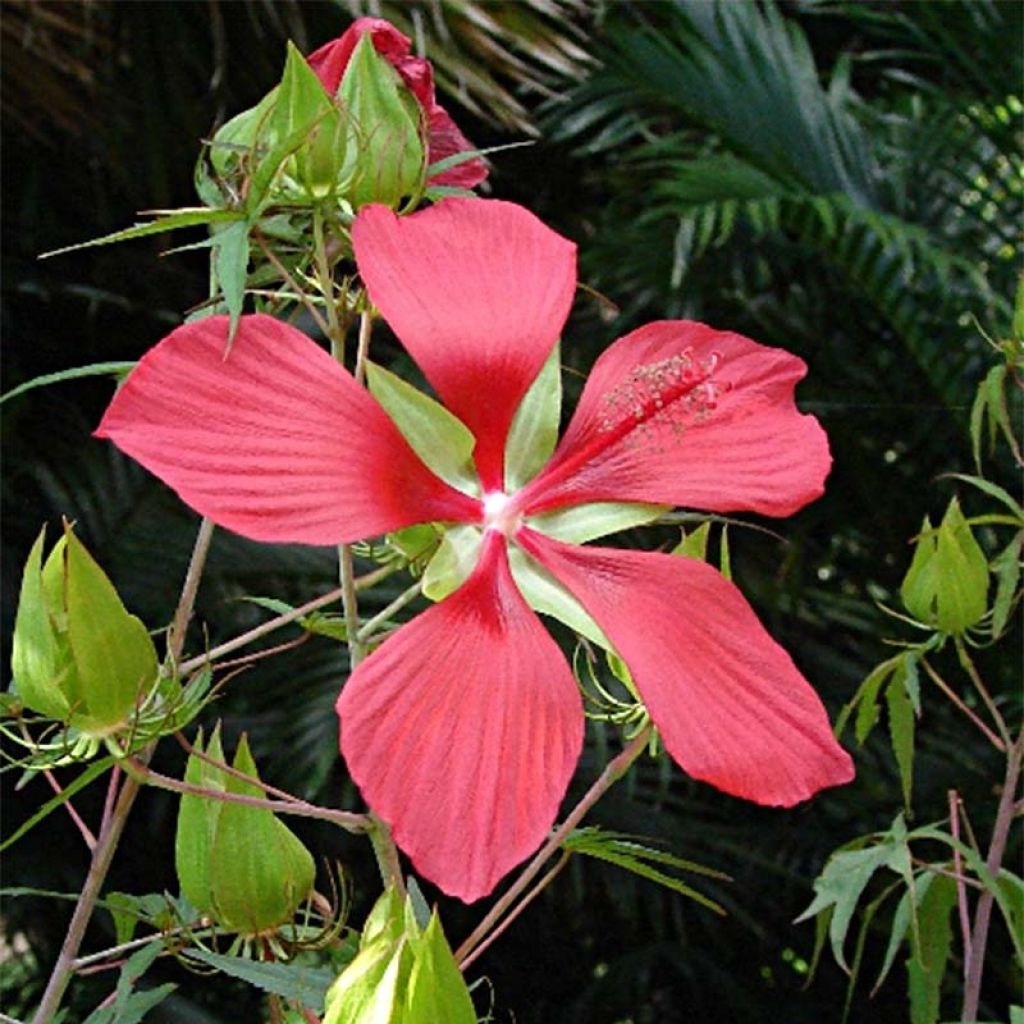

Hibiscus coccineus


Hibiscus coccineus


Hibiscus coccineus


Hibiscus coccineus


Hibiscus coccineus


Hibiscus coccineus


Hibiscus coccineus


Hibiscus coccineus
Hibiscus coccineus
Hibiscus coccineus
American scarlet rose mallow
Although ordered late in the season, the two young plants arrived quickly and in full growth and good condition. Planted, also dry, in a marsh by the riverbank, they still flowered (8 flowers for one, 4 for the other) magnificently and spectacularly for the kayakers. For overwintering, I have some doubts... it gets cold in Alsace. I'm keeping my fingers crossed.
jean camille, 29/12/2025
Special offer!
Receive a €20 voucher for any order over €90 (excluding delivery costs, credit notes, and plastic-free options)!
1- Add your favorite plants to your cart.
2- Once you have reached €90, confirm your order (you can even choose the delivery date!).
3- As soon as your order is shipped, you will receive an email containing your voucher code, valid for 3 months (90 days).
Your voucher is unique and can only be used once, for any order with a minimum value of €20, excluding delivery costs.
Can be combined with other current offers, non-divisible and non-refundable.
Home or relay delivery (depending on size and destination)
Schedule delivery date,
and select date in basket
This plant carries a 24 months recovery warranty
More information
We guarantee the quality of our plants for a full growing cycle, and will replace at our expense any plant that fails to recover under normal climatic and planting conditions.

Would this plant suit my garden?
Set up your Plantfit profile →
Description
Hibiscus coccineus, also known as Scarlet Hibiscus or Texas Star, is a perennial herbaceous plant as spectacular as it is easy to grow in full sun in waterlogged soil in summer. It develops and blooms within a few months, offering large, remarkable, ephemeral red flowers at eye level in summer. It also stands out in autumn with its beautiful yellow foliage. It has a preference for long hot summers, which does not prevent it from surviving severe frost if the soil dries out a little. Absolutely stunning at the edge of a pond, it also thrives in large containers kept very moist on a terrace.
Hibiscus coccineus (synonym Hibiscus semilobatus) is a perennial herbaceous plant with a woody base. It belongs to the Malvaceae family, related to mallow and rose mallow. It is native to the marshes of the southern United States, particularly Florida and Georgia, where it often exceeds 2 m (6.6 ft) in height. In our climates, this scarlet hibiscus produces straight, upright stems every year, quite late in spring, forming a somewhat loose clump 1.5 m to 2 m (4.9 ft to 6.6 ft) tall and almost as wide.
This deciduous plant has compound leaves 10 cm to 15 cm (3.9 in to 5.9 in) wide, finely divided into 5 to 7 narrow lobes, toothed at the edges and pointed at their tips. The foliage is bright green and can resemble hemp or Japanese maple leaves. Towards the end of the season, it takes on lovely yellow and orange hues, especially in warm climates. The flowering period is from July to September, depending on the climate, and lasts about a month. The flower buds appear in clusters at the top of the stems and in the axils of the leaves. They grow and turn red. These buds then open into flat flowers, 15 cm to 20 cm (5.9 in to 7.9 in) in diameter, composed of 5 satin-textured petals ranging from bright red to red-pink, spatulate and well individualised, surrounding a red central column. Each flower lasts only a day, but they renew themselves on the plant day after day. Pollination is carried out by insects. The fruit is a capsule measuring 1 cm to 2.5 cm (0.4 in to 1 in) in diameter.
Marsh hibiscus plants are spectacular and cannot be ignored: some dislike their huge flowers because they can be difficult to integrate into a natural setting, while others love them for the same reasons that make them perfect for a contemporary garden or an exotic scene carefully arranged around a water feature or on a terrace. Hibiscus coccineus bears more elegant flowers than its cousin, Hibiscus moscheutos, and therefore is easier to pair with other plants. It only requires water in summer and is not bothered by watering with hard water, which allows it to be grown in all regions. Growing in pots provides protection, if necessary, from water and severe frost in winter. All marsh hibiscus plants add another dimension to waterlogged beds or pond edges, accompanied by Gunnera, cannas, Ethiopian arum, Rodgersia 'Chocolate Wings', or Colocasia esculenta.
Hibiscus coccineus in pictures






Plant habit
Flowering
Foliage
Botanical data
Hibiscus
coccineus
Malvaceae
American scarlet rose mallow
North America
Planting and care
Mostly known for their shrubby forms, the coccineus species offered here demonstrates that this Hibiscus genus also includes perennials whose above-ground parts die down in winter. These marsh plants are easy to grow and bring a touch of exoticism to the garden.
Plant in spring, in rich and moist soil, in a warm location. Quite hardy (up to -15° C (5° F)) if the soil is drier in winter, they still require winter protection in colder climates when planted in the ground. Growing them in pots allows for controlling the substrate's humidity and does not hinder the growth and flowering of this vigorous plant.
To create a mass planting: Dig a hole 40 cm (15.7 in) in all directions, lined with a waterproof film and filled with a mixture of good garden soil and fertiliser. Maintain a permanently marshy state of humidity during the shoot and flowering period. As soon as the leaves turn yellow in October, simply keep the soil moist. Cut back the stems to 5 cm (2 in) from the ground in spring or late autumn. Growth restarts late in spring, in April-May depending on the climate.
In a pot: use a mixture of garden soil and compost enriched with dried blood and crushed horn. Place your pot in a container or high-sided saucer that will allow the soil to remain saturated with water in summer. Remove this saucer in winter if the plant remains outdoors: the soil will stay cool but not waterlogged. In very cold regions, overwinter your hibiscus in a room (it can be a dark room as the plant will be dormant), protected from severe frost. Water occasionally, just to maintain freshness.
In warm regions, a bit of afternoon shade is welcome. Our experience confirms that Hibiscus coccineus tolerates repeated watering with hard water.
Planting period
Intended location
Care
Planting & care advice
-
, onOrder confirmed
Reply from on Promesse de fleurs
Similar products
Haven't found what you were looking for?
Hardiness is the lowest winter temperature a plant can endure without suffering serious damage or even dying. However, hardiness is affected by location (a sheltered area, such as a patio), protection (winter cover) and soil type (hardiness is improved by well-drained soil).

Photo Sharing Terms & Conditions
In order to encourage gardeners to interact and share their experiences, Promesse de fleurs offers various media enabling content to be uploaded onto its Site - in particular via the ‘Photo sharing’ module.
The User agrees to refrain from:
- Posting any content that is illegal, prejudicial, insulting, racist, inciteful to hatred, revisionist, contrary to public decency, that infringes on privacy or on the privacy rights of third parties, in particular the publicity rights of persons and goods, intellectual property rights, or the right to privacy.
- Submitting content on behalf of a third party;
- Impersonate the identity of a third party and/or publish any personal information about a third party;
In general, the User undertakes to refrain from any unethical behaviour.
All Content (in particular text, comments, files, images, photos, videos, creative works, etc.), which may be subject to property or intellectual property rights, image or other private rights, shall remain the property of the User, subject to the limited rights granted by the terms of the licence granted by Promesse de fleurs as stated below. Users are at liberty to publish or not to publish such Content on the Site, notably via the ‘Photo Sharing’ facility, and accept that this Content shall be made public and freely accessible, notably on the Internet.
Users further acknowledge, undertake to have ,and guarantee that they hold all necessary rights and permissions to publish such material on the Site, in particular with regard to the legislation in force pertaining to any privacy, property, intellectual property, image, or contractual rights, or rights of any other nature. By publishing such Content on the Site, Users acknowledge accepting full liability as publishers of the Content within the meaning of the law, and grant Promesse de fleurs, free of charge, an inclusive, worldwide licence for the said Content for the entire duration of its publication, including all reproduction, representation, up/downloading, displaying, performing, transmission, and storage rights.
Users also grant permission for their name to be linked to the Content and accept that this link may not always be made available.
By engaging in posting material, Users consent to their Content becoming automatically accessible on the Internet, in particular on other sites and/or blogs and/or web pages of the Promesse de fleurs site, including in particular social pages and the Promesse de fleurs catalogue.
Users may secure the removal of entrusted content free of charge by issuing a simple request via our contact form.
The flowering period indicated on our website applies to countries and regions located in USDA zone 8 (France, the United Kingdom, Ireland, the Netherlands, etc.)
It will vary according to where you live:
- In zones 9 to 10 (Italy, Spain, Greece, etc.), flowering will occur about 2 to 4 weeks earlier.
- In zones 6 to 7 (Germany, Poland, Slovenia, and lower mountainous regions), flowering will be delayed by 2 to 3 weeks.
- In zone 5 (Central Europe, Scandinavia), blooming will be delayed by 3 to 5 weeks.
In temperate climates, pruning of spring-flowering shrubs (forsythia, spireas, etc.) should be done just after flowering.
Pruning of summer-flowering shrubs (Indian Lilac, Perovskia, etc.) can be done in winter or spring.
In cold regions as well as with frost-sensitive plants, avoid pruning too early when severe frosts may still occur.
The planting period indicated on our website applies to countries and regions located in USDA zone 8 (France, United Kingdom, Ireland, Netherlands).
It will vary according to where you live:
- In Mediterranean zones (Marseille, Madrid, Milan, etc.), autumn and winter are the best planting periods.
- In continental zones (Strasbourg, Munich, Vienna, etc.), delay planting by 2 to 3 weeks in spring and bring it forward by 2 to 4 weeks in autumn.
- In mountainous regions (the Alps, Pyrenees, Carpathians, etc.), it is best to plant in late spring (May-June) or late summer (August-September).
The harvesting period indicated on our website applies to countries and regions in USDA zone 8 (France, England, Ireland, the Netherlands).
In colder areas (Scandinavia, Poland, Austria...) fruit and vegetable harvests are likely to be delayed by 3-4 weeks.
In warmer areas (Italy, Spain, Greece, etc.), harvesting will probably take place earlier, depending on weather conditions.
The sowing periods indicated on our website apply to countries and regions within USDA Zone 8 (France, UK, Ireland, Netherlands).
In colder areas (Scandinavia, Poland, Austria...), delay any outdoor sowing by 3-4 weeks, or sow under glass.
In warmer climes (Italy, Spain, Greece, etc.), bring outdoor sowing forward by a few weeks.

















































